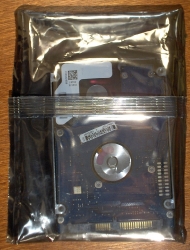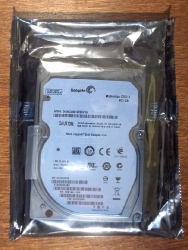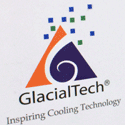Introduction
The Seagate Momentus, for the uninitiated, is a family of 2.5″ hard drives representing a broad range of capacity and features. This Seagate Momentus represents the cream of the crop; a 7200-RPM drive boasting a whopping half-terabyte of capacity. Despite this, the asking price is surprisingly moderate. The drive came to us in minimal OEM packaging (an excellent cost-saving method; you’re just going to throw the glossy box away, aren’t you?) consisting of a crush-resistant plastic carton and a heat-sealed static-proof baggie.
 |
 |
Now what we have here is a very nice Macbook Pro that’s becoming a little long in the tooth. It is a late 2007 revision, top of the line for its time, but it’s beginning to show its age – many of its components are now found on mid-grade machines (cheap junk will always remain cheap junk) and … well, it still plays Crysis but wow the load times. Whatever can we do? Canonically, the easy upgrade for Macs is ‘more ram’. The operating system has a long history of being heavily memory dependent, and system performance can either be massively increased or degraded by memory, and whether you have enough of it. But what, you ask, if you have maxed it out? (Disclaimer: I haven’t, yet) Erhm… hm. Well, you can always turn on virtual memory? No, that’s been enabled by default for a decade. So what if we made that faster? That may just work. And failing that, it’ll still open files and programs faster, and the unusually large cache will speed things further – the more cache, the more efficiently a drive can run. Native Command Queueing stores disk commands as they comes in, and re-orders them to minimize the number and amount of head movements – this increases speed, by minimizing wait times between active data access, this increases the lifespan of the mechanical components that can wear out, and it increases efficiency, because it takes energy to move the heads. And it works best with a big cache.
But what’s the point of such a thing in a laptop? It’s a 7200 RPM drive, don’t they suck power like mad and run incredibly hot? Well actually, no. The Apple OEM drive made by Fujitsu is a 5400 RPM drive, and fairly efficient – it draws 0.60 amps at 5 volts, or 3 watts. This gem also operates at the standard 5 volts, but only draws .451 amps, or 2.25 watts, a full quarter less than the already efficient, if slow, Fujitsu. Bringing this back to heat, I’ll quote the first law of thermodynamics as provided by Wikipedia: “The change in the internal energy [temperature] of a closed thermodynamic system is equal to the sum of the amount of heat energy [electricity] supplied to the system and the work done on the system.” Thus, less watts of electricity in, less watts of heat out. In my system, the hard drive’s idle temperature is currently hovering around 40°c – four to six degrees lower than average temperature with the Apple/Fujitsu OEM drive. And it’s faster? That is an engineering coup, gentlemen.


@dean miller, hey boddy i went to http://www.buyergen.com but i think dis online market is gonna be launched soon.. yet not started… but i liked thyere options anyway.
well… i can give you a online store’s web address… there services are good.. http://www.micropartsusa.com
thanks buddy… best of luck.
thanks buddy for this nice review… i knew a online market place http://www.buyergen.com
but could anybody please suggest me any online store who are specialzed in selling hard drives… powesupplies etc… ?